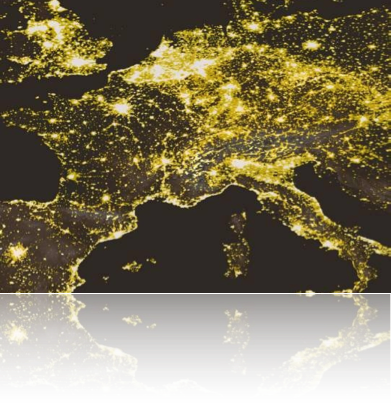The situation of light pollution in the European Union
The First World Atlas of Night Sky Brightness shows that the effects of light pollution in the European Union are impressive. They refer only to the effects on the night sky but anyway they provide a good picture of the amplitude of the many serious effects on the night environment.
More than 99 per cent of the European Union and United States population, and about two-thirds of the World population, live in areas where the night sky is above the threshold for polluted status [i.e. the artificial sky
brightness is greater than 10 per cent of the natural night sky brightness].
In the areas where 96 per cent of the European Union population, 97 per cent of the United States population and half of the World population live, the night sky in standard clean atmospheric conditions is brighter than has been measured with a first quarter moon in the best
astronomical sites.
90 per cent of the European Union population, 93 per cent of the United States population and about 40 per cent of the World population live under a zenith night sky that is brighter than they would have in the same location with a first quarter moon at 15° elevation and zero light pollution. They therefore effectively live in perennial moonlight. They rarely realize it because they still experience the sky to be brighter under a full moon than under new moon conditions.
For about two-thirds of the European Union population, 80 per cent of the United States population and more than one-fourth of the World population the sky brightness is even greater than that measured on nights close to full moon in the best astronomical sites. ‘Night’ never really comes for them because this sky brightness is slightly larger than the typical zenith brightness at nautical twilight.
Assuming average eye functionality, about half of the European Union population, more than two-thirds of the United States population and one-fifth of the World population have already lost the possibility of seeing the Milky Way, the Galaxy where we live.
Finally, approximately one-sixth of the European Union population, 40 per cent of the United States population and one tenth of the World population cannot even look
at the heavens with the eye adapted to night vision, because the brightness is above the night vision threshold. The original paper... Traduction francaise...
[Important Note: Data and the definition of European Union refer to year 1998-99. New EU countries increased EU population of about 21 per cent. They show lower levels of light pollution but they will rapidly reach similar levels, if they will not enforce urgent countermeasures to control light pollution from new lighting installations.]
Informations about light pollution

99 per cent of the European Union population lives in areas where the night sky is polluted.
90 per cent of the European Union population lives under an artificial perennial moonlight.
For about two-thirds of the European Union population ‘Night’ never really comes.
About half of the European Union population has lost the possibility of seeing the Milky Way, the Galaxy where we live.
Approximately one-sixth of the European Union population cannot even look
at the heavens with the eye adapted to night vision due to the high brightness
(data for years 1998-1999)
General information

Measurements of light pollution and night sky brightness in Europe
Lighting design
-
-
More informations



